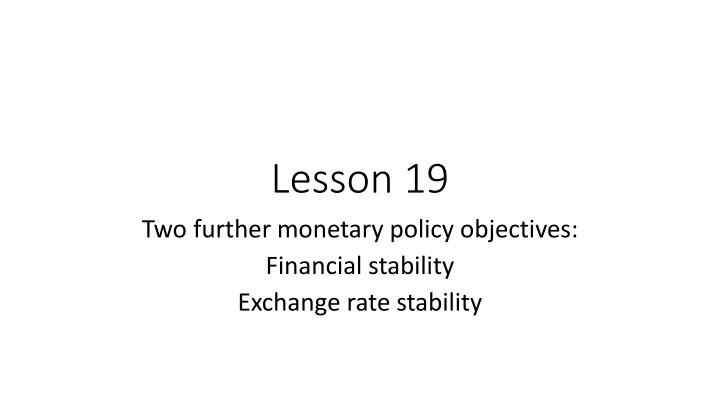
Financial Stability and Exchange Rate Stability
Learn about financial stability and exchange rate stability as essential monetary policy objectives. Financial stability involves a well-functioning financial system, while exchange rate stability aims for stable currency values. Discover the importance of maintaining these objectives for economic health and growth.
Download Presentation

Please find below an Image/Link to download the presentation.
The content on the website is provided AS IS for your information and personal use only. It may not be sold, licensed, or shared on other websites without obtaining consent from the author. If you encounter any issues during the download, it is possible that the publisher has removed the file from their server.
You are allowed to download the files provided on this website for personal or commercial use, subject to the condition that they are used lawfully. All files are the property of their respective owners.
The content on the website is provided AS IS for your information and personal use only. It may not be sold, licensed, or shared on other websites without obtaining consent from the author.
E N D
Presentation Transcript
Lesson 19 Two further monetary policy objectives: Financial stability Exchange rate stability
Financial stability: what is Financial system stability means the effective functioning of the financial system (financial institutions and markets) and the absence of banking, currency and balance of payments crisis. Financial instability is caused by bank failures, excessive asset price volatility, and collapse of market liquidity or a disruption to the payments system. Financial system stability requires a stable macro-economic environment, effective regulatory framework, well organized financial markets, sound financial institutions and safe and robust payments infrastructure. The maintenance of financial stability entails the prevention, detection and reduction of threats to the financial system as a whole, through the surveillance of markets and financial institutions, oversight of the payments system and crisis resolution.
Financial stability The maintenance of financial stability entails the prevention, detection and reduction of threats to the financial system as a whole, through the surveillance of markets and financial institutions, oversight of the payments system and crisis resolution. Usually not a formal objective, but in the genetic code of central banks (T. Padoa-Schioppa) The central bank has no choice but to be a lender of last resort to banks, but should do it with great caution by: Mitigating moral hazard Walter Bagehot (1826-1877): Lend freely at a high rate, on good collateral. Exchanging information with (while being independent from) banking supervisors Coordinating with the fiscal authority with a proper allocation of tasks (central bank should not support insolvent banks; capital losses should be borne by taxpayers)
Exchage rate stability: what is Countries, especially developing ones, pursue stable exchange rates to attract foreign capital. They usually accomplish this by fixing their currencies to that of a more stable country, a practice called pegging. A country's central bank may increase or decrease the money supply to maintain this rate. A stable value of the currency is also a valid instrument to promote exchanges Stable exchange rates generally are viewed as favorable, but there can be drawbacks. The main concern is linked to the loss of monetary authonomy, that in case of economic downturns is an useful instrument to promote recovery The objective of the exchange rate stability in the Euro area is granted through the adoption of a common currency
External adjustment fixed vs floating exchange rates Under fixed exchange rates, balance of payment surplus increase foreign reserves in foreign currency (and therefore increases internal money supply) while balance of payment deficits diminish reserves in foreign currency (and therefore reduces internal money supply) Under floating exchange rates the exchange rate adjusts to equalize demand and supply of foreign currency therefore setting a currency price that automatically sets the balance of payment in equilibrium. The internal money supply is not altered
The exchange rate stability and the impossible trinity The impossible trinity, also called the Mundell-Fleming trilemma or simply the trilemma, expresses the limited options available to a small open economy in setting monetary policy. According to this theory, a country cannot achieve the free flow of capital, a fixed exchange rate and independent monetary policy simultaneously. By pursuing any two of these options, it necessarily closes off the third. According to the trilemma model, a country has three options. It can A - set a fixed exchange rate between its currency and another while allowing capital to flow freely across its borders, B - allow capital to flow freely and set its own monetary policy, or C - set its own monetary policy and maintain a fixed exchange rate.






















